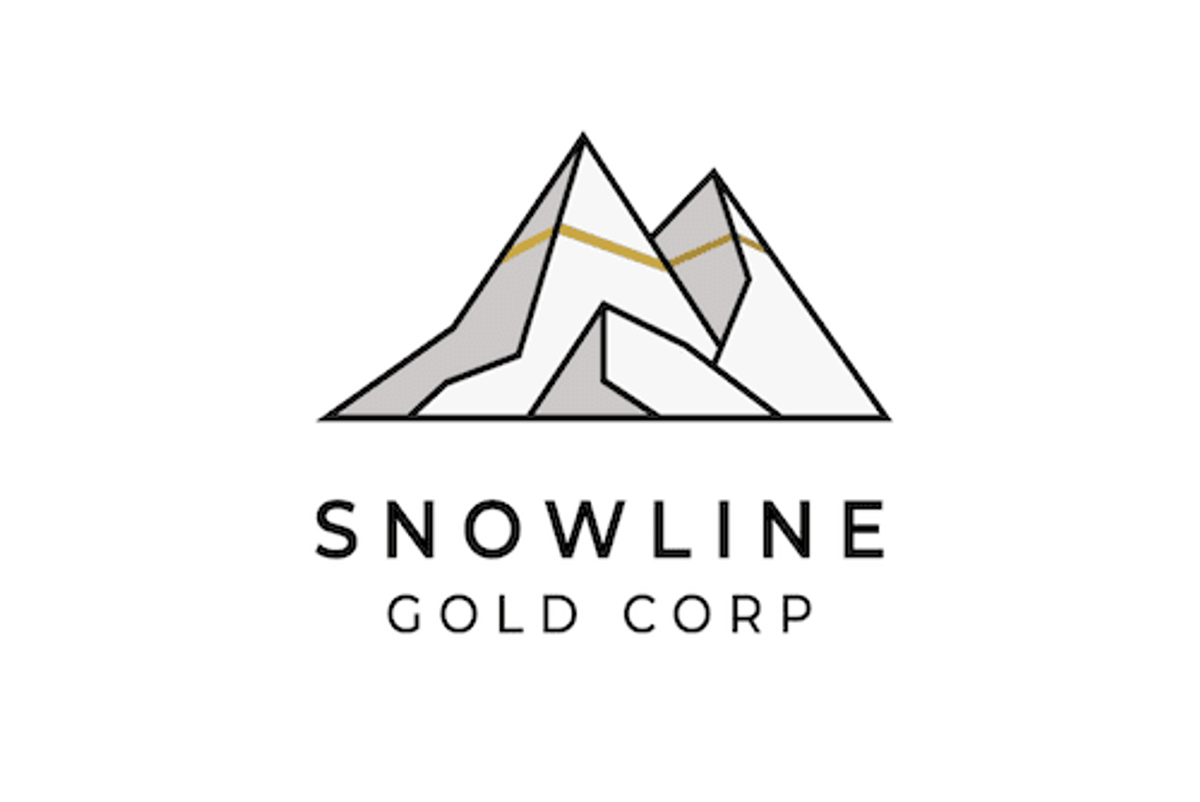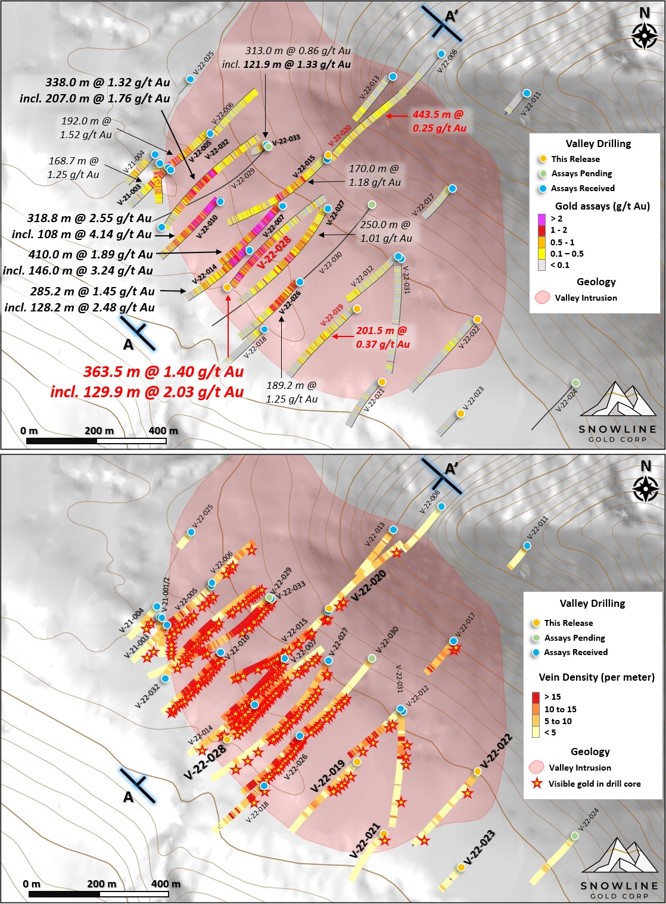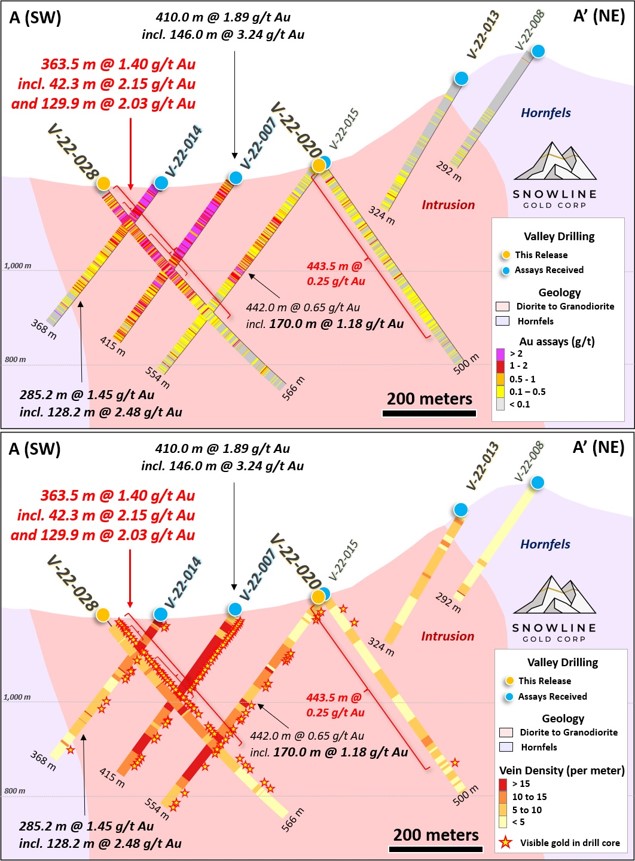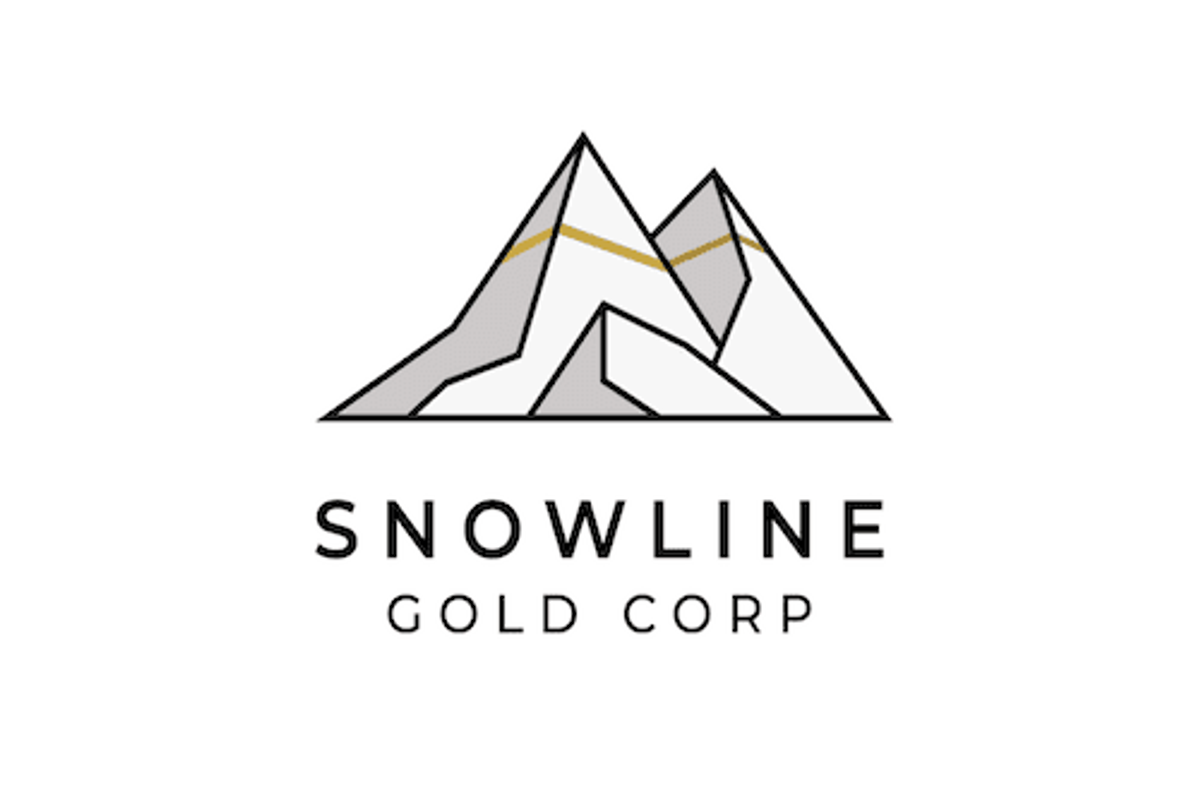
- Hole V-22-028 returned 1.40 g/t Au over 363.5 m from surface, including 2.03 g/t Au over 129.9 m and 2.15 g/t Au over 42.3 m from its Valley Zone
- Additional results extend known strike length of potentially economic gold grades along mineralized corridor to 720 m (open) and delineate gold-bearing quartz vein arrays along relatively underexplored eastern boundary of the Valley intrusion
- Assays still pending for 7 of 32 holes (3,474 m, or 26% of 13,320 m) drilled at Valley and Gracie in 2022.
Snowline Gold Corp. (CSE:SGD)(OTCQB:SNWGF) (the "Company" or "Snowline") is pleased to announce additional preliminary assay results from its 2022 drilling program at the Valley Zone, Rogue Project, Yukon. Notably, hole V-22-028 intersected a zone of sheeted quartz vein mineralization within the Valley intrusion averaging 1.40 gt Au across 363.5 m from surface, including zones of 2.03 gt Au over 129.9 m and 2.15 gt Au over 42.3 m, with additional mineralization at depth (Tables 1 and 2). The hole was collared 121 m from the nearest hole (V-22-014; 285.2 m @ 1.45 gt Au) and drilled northeast, demonstrating continuity of mineralization within Valley's near-surface mineralized corridor. Assays remain pending for 26% (3,474 m) of the 2022 Rogue drill program

Table 1 - Preliminary highlight summary of Snowline's latest assay results. *Interval widths reported; true widths of the system are not yet known.
"We are continually impressed not only by the scale but by the continuity of gold mineralization at Valley," said Scott Berdahl, CEO & Director of Snowline. "Today's results build on earlier holes, with V-22-028 adding significant tonnage with strong gold grades. The hole demonstrates a wide breadth to the mineralized zone and grade continuity between previous holes. In addition, promising mineralization seen in V-22-019 shows potential for the near-surface higher grades to continue to the southeast, while V-22-020 shows widespread mineralization within the Valley intrusion beyond the main gold zones known to us at present. We look forward to receiving additional assays from the 2022 season as we gear up for an exciting exploration program in 2023."

Figure 1 - 2021 and 2022 drilling at the Valley Zone, showing assays received to date (top) and vein densities alongside instances of visible gold observed during logging (bottom). Visual results indicate the presence of a large central zone within the broader Valley intrusion bearing higher vein densities. Initial analytical results for this zone consistently carry unusually high grades for a reduced intrusion-related gold system.

Figure 2 - Cross-section A, showing results received (top) and vein densities alongside instances of visible gold observed during logging (bottom). V-22-028 is collared towards the southeast of the cross-section slice and runs 30-60 m in front of the other holes as shown. Views look northwest.

Table 2 - Summary of mineralization in current holes. Gold intervals are typically long and relatively continuous, with little influence on overall interval grade from unusually high samples evidenced by strong "remainder" assays and strong values after capping assays at 10 g/t Au. *Interval widths reported; true widths of the system are not yet known, with different vein generations, orientations and grade distributions within given intervals through the bulk tonnage gold target.
HOLE V-22-028
Hole V-22-028 was collared near the western margin of the Valley intrusion, 121 m from the collar site for V-22-014 (285.2 m @ 1.45 g/t Au including 128.2 m @ 2.48 g/t Au, see Snowline news release dated November 15, 2022), and drilled towards the northeast into the intrusion. The hole encountered abundant sheeted quartz veins with trace visible gold, returning 1.40 g/t Au over 363.5 m from bedrock surface at approximately 17.0 m depth, including higher grade intervals of 2.15 g/t Au over 42.3 m from 45.0 m and 2.03 g/t Au over 129.9 m from 141.3 m.
The hole extends the known width of near-surface, >1 gram per tonne gold mineralization at Valley, and demonstrates continuity of mineralization between previous holes V-22-014 and V-22-007 (410.0 m @ 1.89 g/t Au including 146.0 m @ 3.24 g/t Au, see Snowline news release dated November 15, 2022) along the western edge of the highest-grade zone of the Valley gold system encountered to date.
As with previous holes at Valley, gold grades are carried across broad intervals, and they are not heavily affected by local high-grade (>10 g/t Au) intersections (Table 2).
HOLE V-22-019
Hole V-22-019 was collared in the Valley intrusion as a step-out along strike of the well-mineralized corridor, roughly 178 m from previous hole V-22-026 (289.7 m @ 0.90 g/t Au including 189.2 m @ 1.25 g/t Au, see Snowline news release dated January 18, 2023). The hole encountered widespread low to moderate density of quartz veins hosting gold mineralization, with five instances of trace visible gold noted during logging. Two primary mineralized intervals returned 0.39 g/t Au over 16.0 m from 71.5 m downhole and 0.37 g/t Au over 201.5 m from 127.0 m downhole, extending the northwest-southeast strike length of potentially economic grades at Valley to 720 m. The system remains open. Given the depth of the observed intervals and the tendency elsewhere along the trend for higher grades near surface, the ground above and around this intersection is considered by the company to be highly prospective. Drilling planned for 2023 will test shallower parts of this area.
From bedrock surface at 19.9 m downhole depth to the bottom of consistent mineralization at 390.1 m downhole depth, including barren intervals within, V-22-019 averaged 0.29 g/t Au over 370.2 m.
HOLE V-22-020
Hole V-22-020 was collared in the Valley intrusion at the pad site of V-22-015 (442.0 m @ 0.65 g/t Au including 170.0 m @ 1.18 g/t Au, see Snowline news release dated December 22, 2022), but drilled at the opposite azimuth, towards the northeast. The hole encountered a low to moderate density of quartz veins dipping to the northeast, generally at low angles to the core axis. The top 443.5 m of the hole averaged 0.25 g/t Au from bedrock surface at 7.5 m, with generally consistent gold mineralization. As with previous hole V-22-006 (Figure 1), zones of increased grade continuity occur towards the northeastern margin of the Valley intrusion, suggesting the possibility of additional grade-controlling features in this lightly explored part of the system. The hole did not exit the intrusion by its end at 500 m downhole depth.
QA/QC
On receipt from the drill site, Valley's NQ2-sized drill core was systematically logged for geological attributes, photographed and sampled at Snowline's 2022 field camp. Sample lengths as small as 0.5 m were used to isolate features of interest, otherwise a default 1.5 m downhole sample length was used. Core was cut in half lengthwise along a pre-determined line, with one half (same half, consistently) collected for analysis and one half stored as a record. Standard reference materials, blanks and duplicate samples were inserted by Snowline personnel at regular intervals into the sample stream. Bagged samples were sealed with security tags to ensure integrity during transport. They were delivered by expeditor and by Snowline personnel to ALS Laboratories' preparatory facility in Whitehorse, Yukon. Sample preparation was completed at different facilities in Whitehorse, Sudbury, ON, Thunder Bay, ON and Langley, BC with analyses completed in Vancouver.
ALS is accredited to ISO 17025:2005 UKAS ref 4028 for its laboratory analysis. Samples were crushed by ALS to >70% passing below 2 mm and split using a riffle splitter. 250 g splits were pulverized to >85% passing below 75 microns. A four-acid digest with an inductively coupled plasma mass spectroscopy (ICP-MS) finish was used for 48-element analysis on 0.25 g sample pulps (ALS code: ME-MS61L). All samples were analysed for gold content by fire assay with an atomic absorption spectroscopy (AAS) finish on 30 g samples (ALS code: Au-AA23). Any sample returning >10 g/t Au was reanalysed by fire assay with a gravimetric finish on a 30 g sample (ALS code: Au-GRA21).
Samples with visible gold and other samples returning >2.0 g/t Au by fire assay, along with a set of randomly selected samples, will undergo further processing, analysing the screen rejects to determine whether the screening process could introduce a sampling bias in current results by excluding coarse gold from analysis, resulting in an under-reporting of true grades. Other biases are also possible.
Results reported herein are considered preliminary following receipt of a low but expected percentage of abnormal assays from standard and blank samples inserted by the Company into the Valley sample stream. (Standard samples are prepared by a third-party laboratory to have known quantities of gold, and blank samples are known to contain very limited concentrations of gold.) Reanalysis of samples run along with these reference materials will provide greater certainty in the final assay numbers. These results will be reported if a material difference is identified between the current assays and the re-run sample batches. Based on the widespread and relatively consistent mineralization throughout mineralized zones, however, the Company does not believe that the re-analysis of this relatively small number of samples will have a significant impact on the preliminary mineralized intervals reported herein.
ABOUT ROGUE
Rogue's Valley Zone is a newly discovered, bulk tonnage style, reduced intrusion-related gold system (RIRGS), with geological similarities to multi-million-ounce deposits currently in production like Kinross's Fort Knox Mine in Alaska and Victoria Gold's Eagle Mine in the Yukon. Early drill results demonstrate unusually high gold grades for such a system present near surface across intersections of hundreds of metres. Gold is associated with bismuthinite and telluride minerals hosted in sheeted quartz vein arrays along the margins of and within a one-kilometer-scale, mid-Cretaceous aged Mayo-series intrusion. Valley is an early-stage exploration project without a resource estimate, and while initial results are encouraging, the presence or absence of an economically viable orebody cannot be determined until significant additional work is completed.
The Rogue Project area hosts multiple intrusions similar to Valley along with widespread gold anomalism in stream sediment, soil and rock samples. Elsewhere, RIRGS deposits are known to occur in clusters. The Rogue Project is thus considered by the Company to have district-scale potential for additional reduced intrusion-related gold systems.
ABOUT Snowline Gold Corp.
Snowline Gold Corp. is a Yukon Territory focused gold exploration company with a seventeen-project portfolio covering >280,000 ha. The Company is exploring its flagship >137,000 ha Rogue and Einarson gold projects in the highly prospective yet underexplored Selwyn Basin. Snowline's project portfolio sits within the prolific Tintina Gold Province, host to multiple million-ounce-plus gold mines and deposits including Kinross' Fort Knox mine, Newmont's Coffee deposit, and Victoria Gold's Eagle Mine. The Company's first-mover land position and extensive database provide a unique opportunity for investors to be part of multiple discoveries and the creation of a new gold district.

Figure 3 - Project location map for Snowline Gold's eastern Selwyn Basin properties. The Valley and Gracie Zones on the Rogue are the sites of Snowline's 2022 drill programs.
QUALIFIED PERSON
Information in this release has been prepared under supervision of and approved by Thomas K. Branson, M.Sc., P. Geo., Exploration Manager for Snowline and a Qualified Person for the purposes of National Instrument 43-101.
ON BEHALF OF THE BOARD
Scott Berdah
CEO & Director
For further information, please contact:
Snowline Gold Corp.
+1 778 650 5485
info@snowlinegold.com
CAUTIONARY NOTE REGARDING FORWARD-LOOKING STATEMENTS
This news release contains certain forward-looking statements, including statements about the Company's drill program, results, implied significance of visual inspection of drill core, and surface work and plans for exploring and expanding a new greenfield, district-scale gold system. Wherever possible, words such as "may", "will", "should", "could", "expect", "plan", "intend", "anticipate", "believe", "estimate", "predict" or "potential" or the negative or other variations of these words, or similar words or phrases, have been used to identify these forward-looking statements. These statements reflect management's current beliefs and are based on information currently available to management as at the date hereof.
Forward-looking statements involve significant risk, uncertainties and assumptions. Many factors could cause actual results, performance or achievements to differ materially from the results discussed or implied in the forward-looking statements. Such factors include, among other things: risks related to uncertainties inherent in drill results and the estimation of mineral resources; and risks associated with executing the Company's plans and intentions. These factors should be considered carefully, and readers should not place undue reliance on the forward-looking statements. Although the forward-looking statements contained in this news release are based upon what management believes to be reasonable assumptions, the Company cannot assure readers that actual results will be consistent with these forward-looking statements. These forward-looking statements are made as of the date of this news release, and the Company assumes no obligation to update or revise them to reflect new events or circumstances, except as required by law.
SOURCE: Snowline Gold Corp.
View source version on accesswire.com:
https://www.accesswire.com/737968/Snowline-Gold-Intersects-3635-M-Of-14-Grams-Per-Tonne-Gold-from-Surface-Including-1299-M-Of-20-Grams-Per-Tonne-Gold-at-Its-Valley-Discovery-Rogue-Project-Yukon
